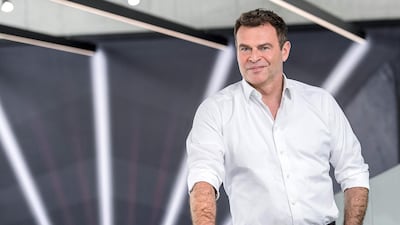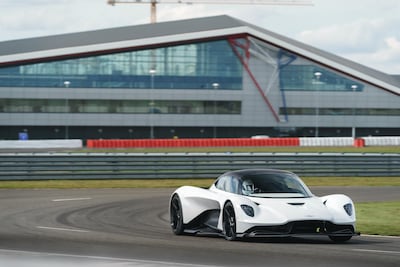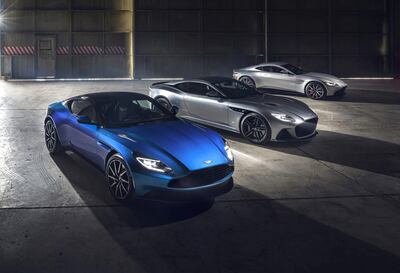Aston Martin, a century-old sports car maker, is planning its path to electrification from 2026. Surprisingly, however, it won’t be sucked into a horsepower war that makes headlines for many start-up electric vehicle companies and even a few of the established players.
"Compared to an internal combustion engine, it's really easy to create a lot of power from an electric motor, but I don't believe in these electric hypercars," says new Aston Martin chief executive Tobias Moers, when asked if we'd be seeing any 2,000 horsepower /400 kilometre per hour electro-rockets in the future.
"What you need in a sports car is 500 kilowatt [670bhp] to 750kW [1,000bhp]. That's a ballpark figure, but it's more than enough," he says, also saying that the big selling point in the future will be a combination of range, charging time and power.
‘Charging times will be the most crucial topic’
Moers joined Aston Martin in August and brings with him an enormous engineering background, having delivered years of record sales to AMG, the performance arm of Mercedes-Benz, as its chief executive since 2013 after joining as an engineer in 1996.
With Mercedes currently owning 5 per cent of Aston Martin, supplying its AMG V8 engines for Vantage, DB11 and DBX, Canadian businessman Lawrence Stroll stepped in last year to top up the coffers with a 16.7 per cent investment. Stroll also enticed Moers to move to the UK to turn Aston Martin's ailing share price around with an engineering-led recovery.
"The future is going to be less about horsepower, more about the best mix of charging time, range and power because it's always a trade-off as to what you need from a battery. Everybody talks about needing 700km of range, but charging times will be the most crucial topic. We have to achieve 20 to 80 per cent charging [state of charge] in 12 to 15 minutes, which should be foreseeable with a 650km to 700km range," says Moers.
‘We’re going to get used to electric motoring but …’
Although Aston Martin is declaring its allegiance to electrification, Moers says he would investigate other zero emission options if they proved viable.
“If it turns the other way and we lose the carbon dioxide and have a liquid, synthetic fuel instead, you can always go back to combustion engines, that's not a problem but I wouldn’t put money on that yet.”
E-Fuels are being developed by Saudi Arabia's Aramco, Shell and Porsche that can run in regular combustion engines and are said to produce more power than petrol with no emissions, charging or range issues.
Moers says that while he believes electrification will become everyday life for motorists, the option is there for E-Fuels in other transport sectors such as aviation, where battery weight cancels out the range and could trickle down to specialist automotive applications.
“There's an industry that needs artificial, zero emission liquid fuel more than cars and they’re flying in the sky, and it might also be an issue for the long-haul trucking business, but for now, I believe in electrification. We’re going to get used to electric motoring, there’s no doubt for sure.”
‘Toolbox of options at our disposal from AMG’
Before the first electric Aston Martin arrives, there is still a raft of updates to the existing range of DB11, DBS Superleggera and Vantage due from this year. Moers confirms that the two mid-engined projects Valkyrie and Valhalla are still on track, despite changing Valhalla's engine from the previously announced 3.0-litre V6 to a turbo V8. It will now resemble the Ferrari SP90 Stradale with real-wheel drive and an electric motor wedged between the engine and transmission.
“For Valhalla, we’re going to use the toolbox of options at our disposal from AMG with the V8 to create a bespoke engine combined with a good amount of electrification.”
The "toolbox" is an amended Technology Agreement signed with Mercedes-AMG – one Moers originally finalised from the other side of the desk at AMG. It now allows Aston Martin access to its performance and efficiency codes so it can personalise the basic German V8 engine for each model.
“When I joined, I planned to invest in the new V6 that was under development for Valhalla, but the prototype wasn’t capable of meeting Europe’s EU7 emission regulations, so we switched to the V8.”
‘Good growth opportunities in the Middle East’
EU7 is due in 2026 and will make life harder for smaller, turbocharged engines to deliver big power, ironically allowing Aston Martin and Mercedes to ensure the bigger-capacity V8 will meet the regulations and extend its life.
The Dh11 million Valkyrie that's being developed with the Red Bull Formula One team will keep its 11,000rpm, mid-mounted Cosworth V12 engine, and the Middle East will be among the first regions to take delivery after July, as several of Aston Martin's 150 global owners are based locally.
Valkyrie will be the hero model, but Aston Martin’s sales success depends on expanding its DBX SUV, which will account for 50 per cent of sales. The current V8 will be joined by a plug-in hybrid and a high-performance V12 suggested to produce “at least 650bhp” before the end of the year.
“We’ve got to create more variants in both directions for luxury and sport because this is a new, bespoke platform that is remarkable because other companies normally share platforms so we need to maximise it,” says Moers.
While Middle East sales for the first quarter were good and surpassed their targets according to Ramzi Atat, head of marketing & communications for Aston Martin, Middle East and Africa, Moers says there is further potential to come from this region.
“I see good growth opportunities in the Middle East, particularly in Dubai and Abu Dhabi. The overall market here seems to be the new normal.”
Globally, Aston Martin enjoyed strong numbers for the first three months of 2021, largely off the back of the DBX with China being 900 per cent up over last year’s first quarter, 300 per cent up for North America and 100 per cent growth across Europe.



